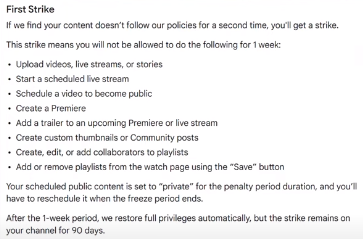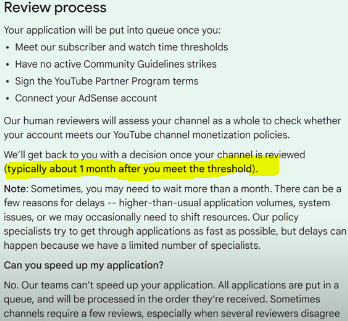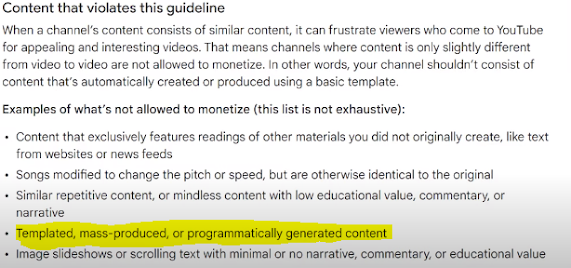YouTube monetization warnings, YouTube monetization time limits, YouTube Monetization processing times,There are 13 questions that every creator has concerning monetization, and when these criteria vary, even the most basic answers to simple inquiries have changed from a year ago, so let's get started.
Community guideline warning.
If you have a community guideline strike, you will be ineligible to apply for monetization,However, strikes are not like warnings.
YouTube understands that creators make mistakes, thus a first-time community violation is usually met with a warning instead of a strike.
This warning does permanently stay on your channel,but it doesn't impact your channel unless you violate community guidelines again, in which case you'll get all of these penalties along with not being able to monetize your channel.
A strike will remain on your channel for 90 days after which you can apply for monetization, but a community guideline warning should not prevent you from applying at any stage.
how long does it take to monetize a YouTube channel?
Once you've met the monetization requirements and applied, YouTube says the review process typically takes one month, but I've seen many channels get monetize in a week or less.
As for how long it takes for the average channel to start from scratch and get 1,000 subscribers and 4,000 hours of watch time, it's a little more difficult to answer.
What I will say based on my experience on the platform, and if you are, as a creator, committed to creating content consistently, you'll be hitting 100 subscribers around about the three-month mark, and 1,000 subscribers after around about a year.
And I would say it's roughly the same for 4,000 hours of watch time, which leads us onto this big question.
Do I have to start again from zero watch hours since I didn't obtain 4,000 hours of watch time in a year?
No! First and foremost, YouTube doesn't reset your watch hours, but what it will do is only count the watch time on your channel from the last 12 months.
So say for example, you've been on YouTube for 10 years, YouTube will ignore nine years worth of watch time.
But anything that was watched on your channel in the last year will count to your watch time requirements, and that will change every single day.
So whatever today's day is go back 365 days, that's what YouTube's gonna count as watch time.
Why is it that my YouTube analytics indicate 50 hours of view time yet the monetization page shows zero public watch hours?
Yeah, let this be a lesson to the wise, the YouTube Studio Analytics page is not your source of truth for monetization watch hours.
Either use the monetization page itself.
First of all, the analytics page doesn't take into account any of the watch time but doesn't count towards monetization requirements.
- private vedios
- unlisted vedios
- deleted vedios
- ad compaigns
But if a monetization screen is saying that you have zero hours of watch time,then that's probably down to YouTube Shorts, more on that later.
What can I do if my country is not in the YouTube Partner Program list?
Unfortunately, some countries are not on the monetization list, be it for political, financial, or legal reasons.
And for those of you in this unfortunate situation, I'm afraid I haven't got
a good answer for you.
Simply put, you won't be able to earn revenue directly from YouTube on your videos, and I strongly recommend not trying to deceive YouTube on this by changing your location within your account.
Basically, that's fraud, YouTube's gonna find that out and terminate your channel,But there are still many ways to make money from your YouTube videos through :
- Sponsorships.
- Brand deals.
- Merch.
- Affiliate links.
And we have seen examples of YouTube channels under 1,000 subscribers earning tens of thousands of dollars.
You won't receive the watch hours if a live broadcast is too long. How long is too long?
This is all to do with public watch hours,and YouTube state that live streams that are:
- unlisted.
- deleted.
- not converted to videos on-demand.
will not count as public watch time for monetization.
And what stops live streams being converted into videos on demand? The length of them.
If a live stream is less than 12 hours, YouTube will automatically archive it turning it into video on-demand content.
But if it's over 12 hours long,it may not be captured at all,so play it safe and stream for 12 hours or less.
Is it possible to monetize videos created with text-to-speech technology?
All right, a bit of a complicated answer this one because I'm sure there are many channels on YouTube that are monetized that do use text-to-speech technology.
But the more artificial intelligence you bring into your video content, the more difficult it is for YouTube to tell whether or not the content has to be made by humans.
YouTube mentioned this in the guidelines about reused or repetitious content, and text to speech could be treated as programmatically generated content.
I don't want to tell you to not use text to speech if it helps you create content and it is for a very intentional reason.
But the spirit of the YouTube Monetization Partner Program is to reward creators for original content, and text to speech technology just makes it a little more difficult for YouTube to differentiate between humans and robots.
Is it possible to monetize videos created with text-to-speech technology?
All right, a bit of a complicated answer this one because I'm sure there are many channels on YouTube that are monetized that do use text-to-speech technology.
But the more artificial intelligence you bring into your video content, the more difficult it is for YouTube to tell whether or not the content has to be made by humans.
YouTube mentioned this in the guidelines about reused or repetitious content, and text to speech could be treated as programmatically generated content.
I don't want to tell you to not use text to speech if it helps you create content and it is for a very intentional reason.
But the spirit of the YouTube Monetization Partner Program is to reward creators for original content, and text to speech technology just makes it a little more difficult for YouTube to differentiate between humans and robots.
I have 1,000 subscribers, but I still need 4,000 hours of watch time because I post YouTube Shorts.
Are there any tips you could give me for getting watch time on a Shorts channel?
My biggest tip would be to stop worrying about subscribers or watch time because the YouTube Partner Program is not designed for YouTube Shorts channel.
Instead, you as a Shorts creator, should be worrying about nothing more than views as that's how you can earn a bonus payout.
And believe you me when I say there will be a lot more opportunities to earn revenue as a Shorts creator in the future.
To earn watch time hours, you're gonna have to make long-form content, and that's probably gonna stretch you a little bit too thin.
My advice to you is to continue developing your skills as a Short-form content expert because I guarantee you in the next couple of years it's really gonna start to pay off.
My most popular video has lots of views, but the music I used in that video was copyrighted.
Is that video still able to earn me money even with the copyrighted music?
Yes, the video will be earning revenue, but none of that is going in your direction, any revenue earned from that video is going to go to the copyright claimant,And this is true, whether or not your channel is monetized.
So I think the advice is pretty simple there, don't use other people's content.
Where is the money I earn from YouTube ad revenue sent to?
First of all, it doesn't matter if it's ad revenue :
- super chats.
- ads.
- Premium.
- Funds.
- merchandise sales.
- membership income.
any money you earn directly from YouTube all goes to the same place, your AdSense account.
If you don't already have an AdSense account, YouTube will guide you through that setup when you are applying for the Partner Program.
One of the steps in that process will be to link a bank account to your AdSense account, and that's where all your YouTube earnings will end up.
The money I made last month on YouTube literally decreased by 60 to 70%, is that normal?
Yep, welcome to the weird, wonderful, and very unpredictable world of CPMs.
Simply put, CPM indicates how much it costs advertisers to put ads on your videos, and this can fluctuate greatly depending on the video topic and the time of year.
For most creators, January is a terrible month for ad revenue because advertisers spend far less money.
So yeah, it is entirely possible that you could get more views and yet earn less revenue from month to month.
That's why relying solely on ad revenue is such a risky YouTube business strategy ,You have so little control over it, and there are many more lucrative and stable business opportunities ready for you to take advantage of.
Thanks for reading see You in the next article.









.jpg)







0 Comment:
Post a Comment